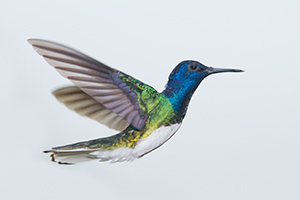You can only find hummingbirds in the Americas. There are almost 360 species of hummingbirds, most of which live in the tropics. Seventeen of those species regularly visit the United States, but only fourteen breed there. Eleven species have been to Florida. Five species reach southern Florida, and only a couple of those could be considered regulars.
But a lot of people don’t even realize that there are hummingbirds in Florida. To find hummingbirds, it is important to know what you are looking for, when to look, and where to look. But the real secret to success is knowing how to “look”.
When To Look For What
Ruby-throated Hummingbird
The Ruby-throated Hummingbird (Archilochus colubris)Info is the most common hummingbird east of the Mississippi River and the most common in Florida. It winters in Central America, Mexico, and Florida. From there it migrates into central Florida and north across the eastern US and into Canada. They are the only species that are in Florida year-round and the only species to breed in the state.
Rufous Hummingbird
Rufous Hummingbirds (Selasphorus rufus)About are probably the most widespread hummingbird in North America, visiting every state except Hawaii. They make a clockwise circuit around western North America and into the South each year in one of the longest migration journeys (measured in body lengths) of any bird. They reach British Columbia by May after moving up the Pacific Coast in late winter and spring. Then in July, they start south again along the Rocky Mountains. In winter, you can find them in several places in Florida, including Miami, but mainly in the northwestern regions.
Others
The other species of hummingbirds would be considered vagrants. Bahama Woodstars (Nesophlox evelynae)eBird are very rare in the US. You can most likely find them in southeastern Florida in late summer to early autumn. A Broad-billed Hummingbird (Cynanthus latirostris)Cornell was last seen in Collier County in February 2016. Buff-bellied Hummingbirds (Amazilia yucatanensis)Wikipedia breed along the Mexican Gulf of Mexico and the whole Yucatan Peninsula. They winter along the northern Gulf of Mexico, mostly west of Florida. Although rare, they have been sighted along both coasts of the Florida Peninsula.
Where To Look (or ‘How To Attract’)
If you live in a condo or have an oppressive homeowners association, a hummingbird feeder may be your only hope for attracting hummingbirds. This Article by the Hummingbird Society and/or this Video by Ace Hardware for Perky Pet should tell you everything you need to know to get started. But for finding hummingbirds or attracting hummingbirds, the simplest thing to do is to find or plant their favorite flowers.
Look for plants with brightly colored (preferably red, orange, or pink) or tubular flowers. Florida native plants known to attract hummingbirds include Coralbean (Erythrina herbacea) and Tropical Sage (Salvia coccinea), which both occur throughout the state. In northern Florida you can also find Cardinalflower (Lobelia cardinalis), Coral Honeysuckle (Lonicera sempervirens), and Crossvine (Bignonia capreolata). Firebush (Hamelia patens) covers South Florida, while Yellow Necklacepod (Sophora tomentosa) seems restricted to southern coastal counties. At the Florida Native Plant Society website, you can click on the botanical name (Italicized and even red on their site) of each of these plants for details and even a picture. Then you can get a better idea of what hummingbirds are looking for.
And Our Secret
Contrary to what I suggested earlier, the real secret to success is not knowing how to look, but how to listen. To see and recognize a hummingbird, you need to have your eyes focused in a very specific direction at a very specific distance at a very specific time and be very lucky. But your hearing is omnidirectional. That means that Nancy can be focused on picking vegetables in her garden, but when she hears the sound of a hummingbird from anywhere around her she can immediately look up and locate her target visually. It is amazing how many more hummingbirds you will notice using this technique.
Nancy describes the sound of hummingbirds as a little shot of electricity, but you don’t have to take her word for it. Many of the better birding websites, like Audubon, the Cornell Lab’s All About Birds site, even Wikipedia, et al., and some phone apps, have recordings of the sound of each bird of interest. For example, here is a recording of the Ruby-throated Hummingbird. At the bottom of the right column of this site are a couple of recordings of the Rufous Hummingbird.
[note 5/7/2023: My “new” third app is Merlin by the Cornell Lab. I’m not sure I have room for more than two of these apps, but it’s too early to know which one won’t make the cut. They are all good and your answer to that question may boil down to personal preferences.]
Conclusions
That’s pretty much everything I know. Familiarize yourself with the sounds of hummingbirds, and you will be surprised how many more hummingbirds you notice in South Florida (or anywhere else you live in the Americas). Now that you know they are here, you can improve your odds by planting a few of their favorite native flowers. Not only is the routine maintenance of this idea less than that of a hummingbird feeder, but some of these plants will also attract butterflies.
So far, we have no pictures of our native hummingbirds. We have one image, our White-necked Jacobin (plus six more in our Birder CollectionIndex) of hummingbirds from Trinidad and Tobago.

We welcome comments, so if you have any questions, or can add some insight, make your comment below.
Leave a Reply